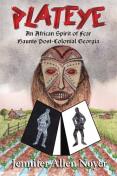BKMT READING GUIDES
Plateye: An African Spirit of Fear Haunts Post-Colonial Georgia
by Jennifer Noyer
Paperback : 256 pages
1 club reading this now
0 members have read this book
The mythical figure of Plateye has floated through the folklore of the deep south of the United States as a kind of demon who searches out human weakness and terrifies his victims.
The novel Plateye is based on the author's family background in Georgia ...
Introduction
The mythical figure of Plateye has floated through the folklore of the deep south of the United States as a kind of demon who searches out human weakness and terrifies his victims.
The novel Plateye is based on the author's family background in Georgia during the years 1797 to 1830. Plateye is a metaphor for the effects of slavery on both white and black people of that era. Drewry Allen, a veteran of the Continental Army, drifts to North Carolina to claim Elizabeth Yarborough, his promised bride, and establishes a farm on the Georgia frontier, where he has been granted land. He builds a profitable farm, but his emotionally fragile wife is saved from total breakdown by the slave woman Dilby. Her strength of character, gifts of healing, and genuine friendship bolster the Allen marriage. After she heals the paralysis of their son, James, conflict with the religious community develops, threatening Dilby with charges of witchcraft. After her cabin is set afire, Dilby is secretly smuggled off the farm. Her son, Josh, accompanies James to an academy in Augusta; James falls in love with Chloe, an educated Creole girl whose African heritage is concealed by Monsieur Chauvin, the academy head and her master. Dilby’s healing skills motivate James to study medicine in Paris. There, Chloe, his tutor in French, has a child by him, and is threatened by Chauvin. Huntington’s Chorea has attacked the schoolmaster’s body—a genetic flaw for this racial fanatic. Plateye hovers as a malignant force.
The characters, living in the frontier lands of Georgia at the beginning of the 19th century, are all fictional although the family name Allen was the author's own before marriage. Some childhood experiences of James Allen and his siblings are recorded in the author’s written family history, but have been rearranged to appear at the time of the novel. Old timers, some born in the 1860s, have written in History of Pike County Georgia: 1822 – 1989 that some white men in the communities there supported two families, one black and one white. This novel is a creative speculation on that situation. It is a device to explore the conflict between the forces of love and social rejection: fear and hatred in conflict with friendship and desire.
Discussion Questions
No discussion questions at this time.Book Club Recommendations
Recommended to book clubs by 0 of 0 members.
Book Club HQ to over 90,000+ book clubs and ready to welcome yours.
Get free weekly updates on top club picks, book giveaways, author events and more








